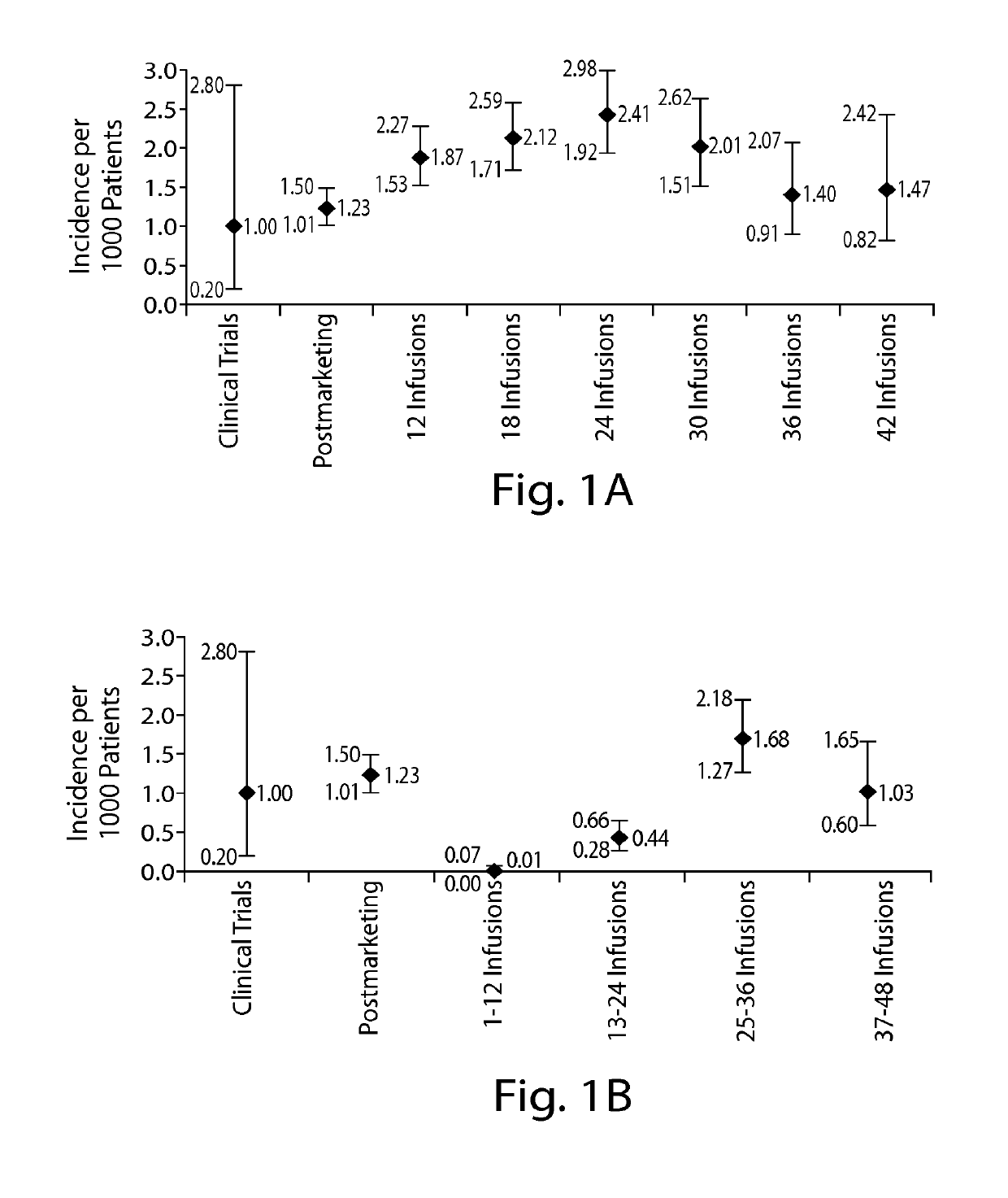Method of assessing risk of pml
a technology of assessing the risk of pml, which is applied in the direction of instruments, dsdna viruses, drug compositions, etc., can solve the problems of increasing the risk of progressive multifocal leukoencephalopathy (pml) and opportunistic brain infections, so as to improve performance and improve performan
- Summary
- Abstract
- Description
- Claims
- Application Information
AI Technical Summary
Benefits of technology
Problems solved by technology
Method used
Image
Examples
example 1
in MS Patients was Quantified for the First Time Using the Two Established Risk Factors and Anti-JCV Antibody Status as Determined by a Unique, Two-Step VP1 VLP-Based ELISA
[0260]Methods
[0261]Patients, Samples and Data Collection
[0262]Due to the infrequent occurrence of PML, data on natalizumab-treated PML patients were collected from several sources including post-marketing data from the Biogen Idec global natalizumab safety database and clinical trials as of Mar. 4, 2011. Prior immunosuppressant use data were not available for all patients exposed to natalizumab; therefore, the proportion of patients with and without prior immunosuppressant use in the TYSABRI® Global Observational Program in Safety (TYGRIS; NCT00477113, NCT00483847) was used as an estimate for the overall natalizumab-treated population. TYGRIS is an observational cohort study designed to obtain long term safety data in natalizumab-treated MS patients in a clinical practice setting. Assessment of anti-JCV antibody p...
example 2
JCV Antibody ELISA was Validated at Clinical Laboratories to Demonstrate the Robustness of the Method
[0294]A novel, 2-step enzyme-linked immunosorbent assay (ELISA) that detects anti-JCV antibodies in human serum or plasma was recently described (see PCT / US2011 / 020832). The key attributes of the assay include both direct binding and in-solution competition components; use of well characterized preparations of JC virus-like particles (VLP); inclusion of appropriate quality control (QC) samples; statistical determination of assay cut points using a large number of longitudinally collected clinical samples; normalization of the signal of the assay; and detection of several isotypes of anti-JCV antibodies (including IgG, IgM, IgA, and IgE).
[0295]The anti-JCV antibody ELISA was validated at three clinical laboratories in order to demonstrate the robustness of the method. Analytical validation was performed by evaluation of intra- and inter-assay precision, analytical specificity and sens...
example 3
Two-Step JCV Assay (the Gen2 Assay) Provides More Accurate Results than the Original Assay (Gen1 Assay)
[0298]The two-step anti-JCV antibody assay was modified following optimization rounds. The new assay differs from the first in at least the follow ways:[0299]HPVLP is used at a substrate concentration of 0.4 μg / mL on plates in the first step, and in solution in the confirmatory assay, as opposed to 1 μg / mL used in the Gen1 assay;[0300]Patient serum is diluted 1:101 prior to applying to HPVLP on plates in the first step of the assay, or to HPVLP in solution in the confirmatory assay, as opposed to 1:200 in the Gen1 assay;[0301]The secondary reagent (anti-human IgG) conjugated to HRP is typically diluted 1:20,000 (but may have to be readjusted for new lots to match signal to previous lot), and the incubation time with the conjugate is only 30 min. In the Gen1 assay, the same reagent was diluted 1:80,000 and incubation time was 60 min;[0302]the binding reaction is assayed by incubatin...
PUM
 Login to View More
Login to View More Abstract
Description
Claims
Application Information
 Login to View More
Login to View More - R&D
- Intellectual Property
- Life Sciences
- Materials
- Tech Scout
- Unparalleled Data Quality
- Higher Quality Content
- 60% Fewer Hallucinations
Browse by: Latest US Patents, China's latest patents, Technical Efficacy Thesaurus, Application Domain, Technology Topic, Popular Technical Reports.
© 2025 PatSnap. All rights reserved.Legal|Privacy policy|Modern Slavery Act Transparency Statement|Sitemap|About US| Contact US: help@patsnap.com



